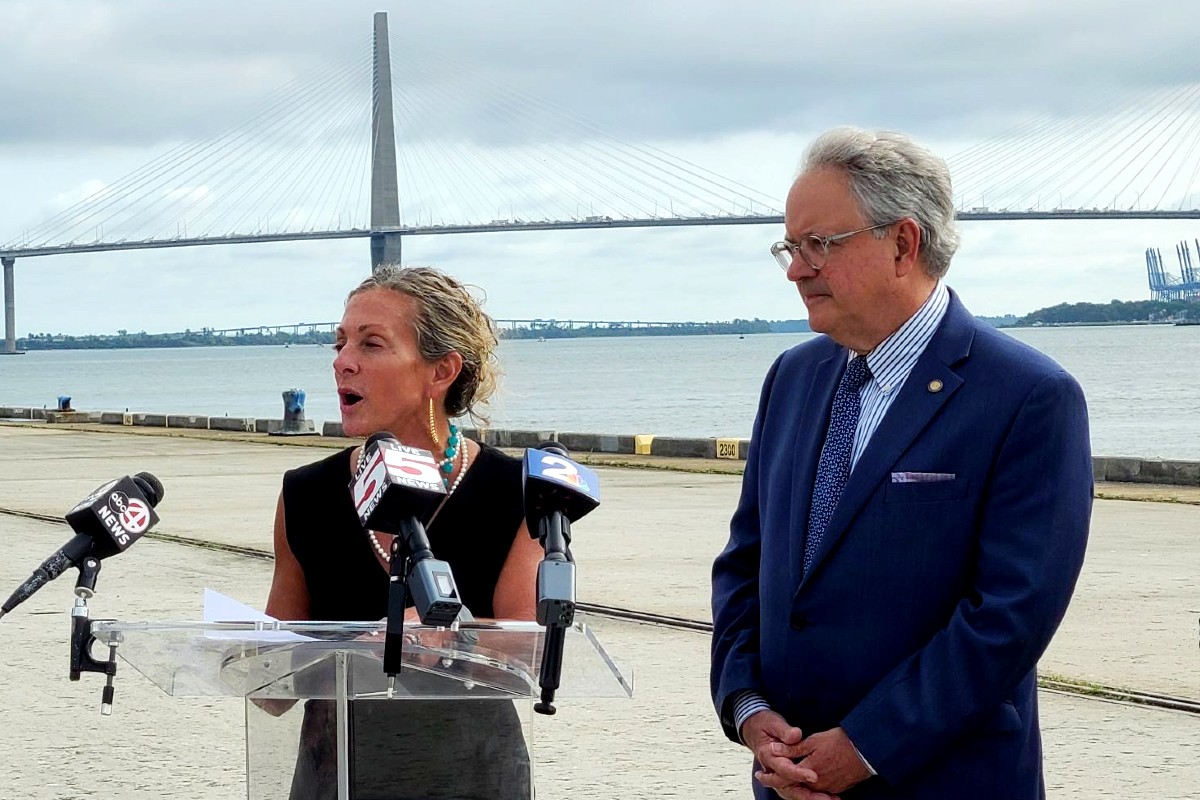
By Skyler Baldwin | The controversial Union Pier development project in Charleston is on pause for the next year, S.C. State Ports Authority (SPA) President and CEO Barbara Melvin announced today. In addition, the plan will now be led by the city of Charleston and prioritize more community input, she said.
The state agency’s decision, which followed a late Thursday announcement of a 9 a.m. press conference, is the result of months of pushing by the agency and a corresponding onslaught of negative public feedback on the project’s direction.
“For the past year, we have engaged extensively with the community,” Melvin said. “We heard from hundreds of residents. We consistently met with city leaders, stakeholders, neighborhood groups and residents. People shared with us what they wanted to see at Union Pier, and more importantly, what they did not want to see at Union Pier.”
Critics have complained that the project was too big, too fast and too out-of-scale for historic Charleston and neighborhoods that feature two- to three-story residential units, not blocks of eight-story chunks of commercial buildings.
“The same themes kept emerging,” Melvin continued. “We heard the calls to slow down the process and gather even more community input. We heard the need for this process to be city-led with third-party experts weighing in on every aspect of the proposal. We heard the desire for less density and height and more green space. We heard that future development must address resiliency concerns, traffic demands and affordable housing.”
Earlier this week, S.C. Rep. Wendell Gilliard, D-Charleston, wrote a letter to Melvin urging her to pause and reset the redevelopment of the pier, citing concerns over the lack of communication and transparency during the planning process.
Key intentions remain the same
Melvin said the core elements of the plan are projected to remain the same: a mixed-use neighborhood development that expands waterfront access, creates public parks and greenspace and connects residents with cultural assets like the nearby International African American Museum.
But now, there is an intentional effort to be more inclusive.
“We have a forever opportunity to prove public access to one of the most beautiful places in America right here,” said Charleston Mayor John Tecklenburg.
Preservation Society of Charleston President and CEO Brian Turner said the pause is an opportunity not to scrap the project entirely, but to build on the good ideas that have been brought to the table already.
“I think we build on the good ideas,” he said. “I think that’s the right thing to do — that’s the community minded thing to do. We never came out and said we need to go completely back to the drawing board. What’s been brought to the table — there were a lot of good components on that, and we need to build on those components.”
Winslow Hastie, the president and CEO of the Historic Charleston Foundation (HCF) that has been working to reframe the project, said the slowdown has great merits for Charleston.
“This pause and change in planning direction is a tremendous opportunity for the people of Charleston for this once in a lifetime opportunity to transform Union Pier, and to make it Charleston,” he told the Charleston City Paper. “It will allow a truly collaborative and community-led planning process.
“We are appreciative of the SPA for hearing Charleston’s voices, which were numerous and well informed. This is also a testament to the power of community-led advocacy and the strong collaboration between HCF, Preservation Society of Charleston and the Coastal Conservation League, and others.”
Big changes coming nonetheless
While the core elements of the project may be holding fast, public leaders have voiced several concerns with the previous proposal and its direction.

“The major community concerns have really been around height, density and public realm components like open space and the assurances the community has that this will be for them, and not just a resort for other people,” Turner said. “In this community-led process, we’re going to be able to bring those values to the table and put them in place. The city will have tools to benchmark the next rezoning application again … that’s exactly what we asked for.”
Tecklenburg said he could envision six main tracks for the project’s new direction:
- Update the comprehensive city plan to define what the future planning area will look like;
- Address resiliency elements of the project site to not only manage stormwater, but protect residents from potential storm surge and rising sea levels;
- Set the architectural tone to ensure the development looks and feels like Charleston;
- Solidify plans for public parks and greenspace, including what features the public would like to see;
- Determine avenues for financing the development, including options for a tax increment finance district;
- Ensure traffic and transportation remains equitable, accessible and does not have a negative impact on the rest of the city.
Turner said the Union Pier project represented a tipping point for the Charleston community.
“The stuff people see going on — people are asking questions,” he said. “There’s no other opportunity like this in terms of acreage in the heart of the town people know. People need certainty that this isn’t just going to be a massive scar on the city.”
Turner added that this is not only a step forward in sending a message to the community that local advocacy groups have been effective, but it also serves as a note to other developers “who want to capitalize on what we’ve built in this city.”
A year-long reevaluation
Tecklenburg said he will be meeting with a coalition of local advocacy groups — the Preservation Society of Charleston, the Coastal Conservation League, and HCF — on Friday to begin outlining a new path forward.
“Today is, in a way, a day of celebration,” he said. “But to get it right, we have to go to work.”
The Joseph P. Riley Jr. Center for Livable Communities will also be engaged to guide and vet plans, and the National Trust for Historic Preservation will be engaged in the process as well, acting as third-party consultants throughout the process.
Several other local groups have also pulled up a seat at the table, including the Charleston Metro Chamber of Commerce, the Charleston Trident Association of Realtors and Explore Charleston.
“We are so fortunate to live in a place where people care so much about their city,” Melvin said. “We, too, care deeply about what happens here. We believe that we will have a new plan that all can embrace.”
More details regarding the future plans and proposals of the project will come as talks commence, Tecklenburg said.
Charleston City Council member Shahid will host his monthly constituent meeting Saturday morning, where he plans to bring representatives of organizations for and against the current proposal to speak. The public meeting is set for 10 a.m. June 17 at Founders Hall at Charles Towne Landing in West Ashley.
- Skyler Baldwin is a reporter with the Charleston City Paper. Have a comment? Send to: feedback@statehousereport.com.
















 We Can Do Better, South Carolina!
We Can Do Better, South Carolina!
Please incorporate into this development electrical power supply for the docked vessels, and disallow the diesel-fueled idling that pollutes our community.
Thanks